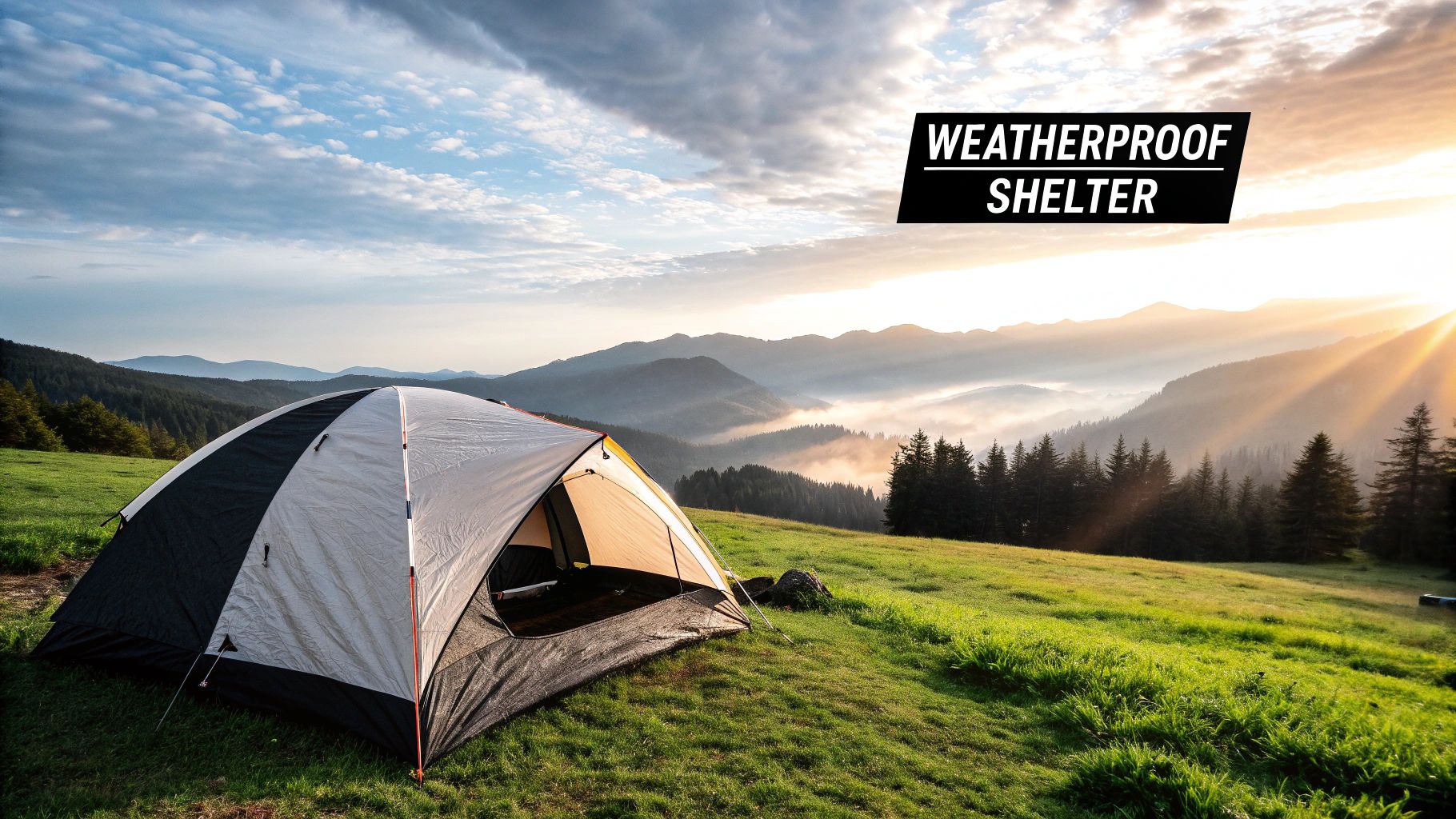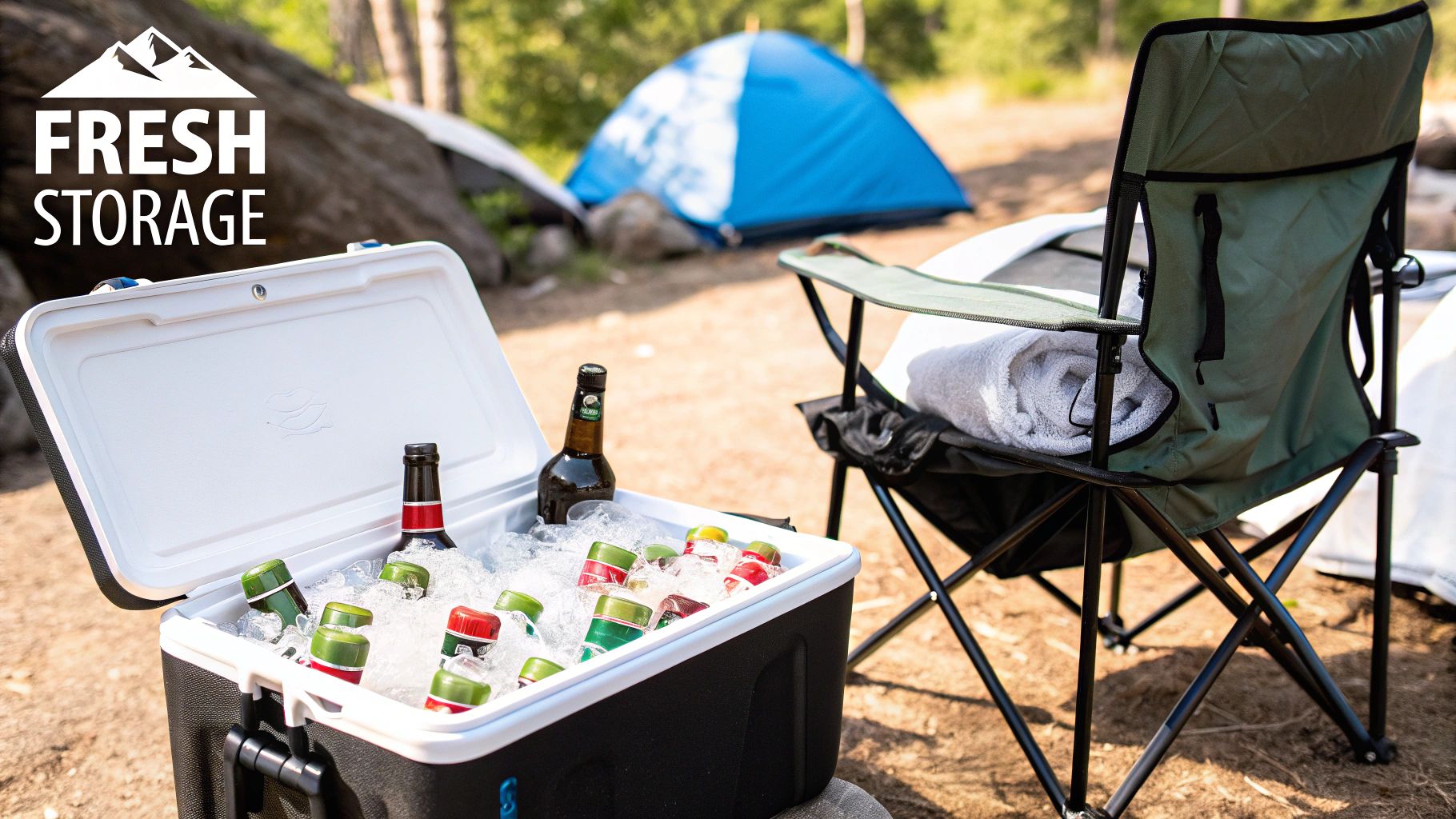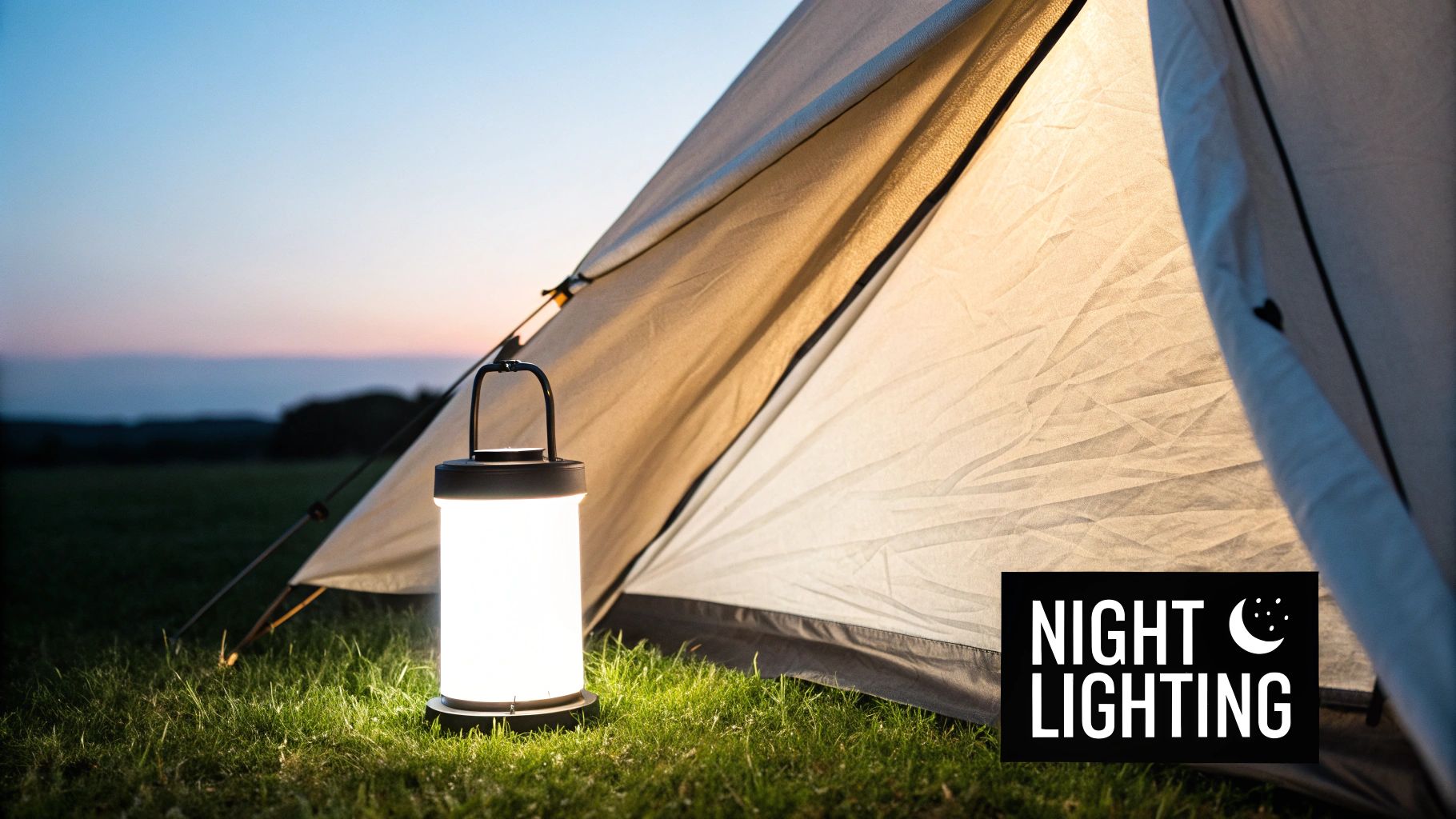With over 10,000 orders
With over 10,000 orders

Photo by Brian Erickson on Unsplash
Car camping offers the perfect blend of outdoor immersion and convenient comfort, but a successful trip hinges on being well-prepared. It's about more than just throwing a tent in the trunk; it's about curating a mobile basecamp that transforms any campsite into a home away from home. Forget roughing it. With the right gear, you can enjoy gourmet meals, restful sleep, and a relaxing lounge area, all just steps from your vehicle.
This comprehensive guide breaks down the top nine car camping essentials that elevate your experience from basic to brilliant. We move beyond generic checklists to provide actionable insights, specific gear recommendations, and expert tips to ensure you have everything needed for a safe, comfortable, and memorable adventure. Whether you are a solo explorer, a family on vacation, or a hiker needing a reliable base, this list covers the foundational systems for your setup. Let's gear up and get ready to redefine your camping trips for 2025 and beyond.
The foundation of any list of car camping essentials is a reliable shelter, and for maximum versatility, a four-season tent is an unparalleled investment. Unlike ultralight backpacking models, car camping allows for the luxury of space and robust construction. A quality four-season tent isn’t just for winter; its sturdy frame and durable fabric provide a fortress against unexpected high winds on a coastal trip, heavy spring downpours, or offer superior ventilation during a sweltering summer night. This adaptability makes it a true cornerstone of your gear collection.

Think of your tent not merely as a place to sleep but as your primary living space and refuge. The key is to balance a spacious interior with practical features. Look for models with near-vertical walls and a high peak height, allowing you to stand and change comfortably. Large vestibules are critical for storing muddy boots and damp gear outside the main sleeping area, while multiple doors prevent you from having to climb over campmates for a late-night exit.
To get the most out of your shelter, follow these best practices:
A quality tent provides shelter, but a well-thought-out sleep system is what delivers a truly restorative night's sleep in the great outdoors. This is more than just a sleeping bag; it's a trio of components working together: the sleeping bag, the sleeping pad, and the pillow. As part of your car camping essentials, this system’s primary role is to provide both comfort and, more critically, insulation from the cold ground, which can rob your body of heat far faster than the air. A plush, high-quality sleep system is one of the greatest luxuries that car camping affords over backpacking.
Think of your sleep system as your personal micro-climate. The sleeping pad insulates you from below, the bag traps your body heat from above, and the pillow supports your head for proper alignment. For maximum comfort, car campers can opt for thicker, self-inflating pads or even memory foam toppers that are too bulky for backpacking. Popular sleeping bag options range from the budget-friendly Kelty Cosmic series to the versatile Marmot Trestles, each designed to meet different temperature needs and material preferences.
To guarantee a warm and comfortable night, integrate these best practices:
While cooking over an open fire has its rustic charm, a dependable cooking system is one of the most crucial car camping essentials for consistent, delicious, and efficient meals. Relying solely on a campfire can be risky due to fire bans, damp wood, or windy conditions. A portable stove provides a controlled flame, allowing you to boil water for coffee in minutes or simmer a chili for hours, regardless of the weather. This reliability transforms your campsite from a survival scenario into a comfortable outdoor kitchen.

Your cooking setup is the heart of your camp kitchen, impacting morale and nutrition. Classic two-burner models like the Coleman Classic Propane Stove offer familiarity and space for multiple pots, while more powerful units like the Camp Chef Explorer series can handle gourmet meals for large groups. Choosing the right system involves balancing portability, fuel type, and cooking style. Having the right tools ensures you can prepare everything from simple oatmeal to elaborate dinners, making every meal a highlight of the trip. To dive deeper into this topic, learn more about how to choose camping cookware on trekology.com.
To master your camp cooking setup, keep these best practices in mind:
A robust cooler and food storage system is a non-negotiable component on any list of car camping essentials. Gone are the days of flimsy styrofoam boxes; modern coolers leverage advanced rotomolded construction and pressure-injected insulation to keep food fresh and drinks cold for days, not hours. This technology is crucial for food safety and elevates your entire culinary experience, allowing you to bring perishable items like meats, dairy, and fresh produce without worry. Proper food storage also means keeping your supplies secure from wildlife, which is vital for both your safety and the animals' well-being.

Your cooler acts as a portable refrigerator, so choosing the right one and using it effectively is key. High-end options like the YETI Tundra or Pelican Elite series offer exceptional ice retention and are often certified bear-resistant, making them ideal for multi-day trips in bear country. For weekend excursions or those on a tighter budget, coolers like the Coleman Xtreme series provide excellent performance. The goal is to create an organized system that minimizes air exposure and maximizes thermal efficiency, turning your campsite into a well-stocked, functional outdoor kitchen.
To master your campsite food and beverage game, implement these proven strategies:
When the sun dips below the horizon, your campsite transforms, and a reliable lighting system becomes one of the most critical car camping essentials. A well-planned setup goes beyond a single flashlight; it involves a layered approach using headlamps, lanterns, and perhaps even string lights to ensure safety and comfort. This comprehensive solution illuminates everything from cooking at the picnic table to navigating tent guylines on a late-night trip to the restroom. Modern LED technology means you can have powerful, long-lasting, and energy-efficient light without bulky equipment.

Think of your lighting in terms of zones: personal, task, and ambient. A headlamp, like those from Petzl, provides focused, hands-free light for personal navigation and tasks. An area lantern, such as a Black Diamond model or a Goal Zero Lighthouse, casts a broad, soft glow perfect for illuminating the main camp kitchen or social area. This combination allows you to move freely and perform activities safely after dark, turning your campsite into a functional and welcoming space.
To get the most out of your lighting gear, follow these best practices:
One of the greatest luxuries of car camping is transforming your site into a comfortable outdoor living room, and the right furniture is central to that goal. While logs and cooler tops can serve in a pinch, dedicated camping chairs and a stable table elevate the experience from rustic survival to genuine relaxation. These pieces of gear are crucial car camping essentials because they provide a designated space for meal prep, dining, playing cards, or simply unwinding with a book by the fire, saving your back and keeping your food out of the dirt.
Think of your camp furniture as the framework for your daily activities. A sturdy table becomes the kitchen counter and dining surface, while a comfortable chair is your personal base for every moment of rest. The market offers a wide range of options, from ultralight, packable models like the Helinox Chair One to classic, budget-friendly options like the Coleman Quad Chair. The key is finding furniture that balances portability, comfort, and durability for your specific needs.
To select and use your camp furniture effectively, consider these best practices:
Perhaps the most critical resource on any trip is a reliable supply of clean water, making a robust system for water storage and purification one of the non-negotiable car camping essentials. While it's tempting to rely on single-use plastic bottles, a dedicated system is more sustainable, cost-effective, and ensures you're prepared for any situation. Having a large, centralized water container combined with a dependable purification method provides security, whether you're filling up at home, a campground spigot, or treating water from a natural source.
Your system should address both bulk storage and on-the-go needs. A large, durable container like a 7-gallon Aquatainer serves as your base camp reservoir for drinking, cooking, and cleaning. This is complemented by a high-quality filter or purifier, such as a Sawyer Squeeze or a gravity-fed system like the LifeStraw Family. This dual approach means you can bring a large supply of known-safe water from home while also having the capability to safely refill from a stream or lake if needed, granting you ultimate flexibility and peace of mind.
To ensure you stay hydrated and healthy, implement these key practices:
While often overlooked, a well-stocked first aid kit and emergency supplies are among the most critical car camping essentials. The convenience of being near your vehicle doesn't eliminate the risks of cuts, burns, sprains, or more serious incidents that can occur miles from immediate help. A pre-built kit like those from Adventure Medical Kits provides an excellent, outdoor-specific foundation, but true preparedness comes from customizing it for your group and potential scenarios. This isn't just a box of bandages; it's your frontline response system for ensuring a minor issue doesn't become a major emergency.
Think beyond basic scrapes. Your kit should contain supplies for wound care, blister treatment, pain relief, and allergic reactions. The "emergency supplies" component is equally vital. This includes a reliable multi-tool like a Leatherman for gear repairs, a headlamp with extra batteries, and potentially a Personal Locator Beacon (PLB) like those from Garmin for areas with no cell service. Having these items accessible and knowing how to use them provides peace of mind, allowing you to relax and enjoy your trip fully.
To ensure your kit is ready when you need it, follow these best practices:
A tent provides excellent sleeping shelter, but a dedicated tarp or canopy is one of the most transformative car camping essentials for creating a genuinely comfortable outdoor living area. These versatile sheets of waterproof material create a crucial buffer zone, offering shade from the relentless sun or a dry refuge during an unexpected downpour. This allows you to cook, relax, and organize gear comfortably, regardless of the weather, effectively doubling your usable campsite space and ensuring a sudden shower doesn't send everyone scrambling into their tents.
Think of a tarp as the roof of your outdoor porch. It protects your kitchen setup from rain, your chairs from bird droppings, and your skin from UV rays. Options range from simple, lightweight tarps like those from Sea to Summit to pop-up canopies from brands like Coleman that offer instant setup. The key is to have a dedicated shelter that protects the space between your car and your tent, creating a functional and protected hub for all your campsite activities.
To maximize the utility of your secondary shelter, keep these practices in mind:
| Item | Implementation Complexity 🔄 | Resource Requirements ⚡ | Expected Outcomes 📊 | Ideal Use Cases 💡 | Key Advantages ⭐ |
|---|---|---|---|---|---|
| Four-Season Camping Tent | Moderate setup with poles and clips | High (space, weight, cost) | Weather protection, comfortable sleeping | Car camping, family trips needing space | Spacious, weather-resistant, comfortable |
| Sleeping Bag System | Low to moderate; selection based on rating | Moderate (varies by insulation type) | Warmth and comfort during sleep | All seasons, varied temperature camping | Temperature-specific warmth, compact |
| Portable Camping Stove & Cookware | Moderate; requires fuel, maintenance | Moderate to high (fuel, cookware weight) | Hot meals; cooking flexibility | Cooking in camp, fire-restricted areas | Precise heat control, fast cooking |
| Cooler and Food Storage System | Low; requires ice and restocking | High (weight, space, cost) | Keeps food/beverages fresh and safe | Extended trips, wildlife-prone areas | Long ice retention, food safety |
| Portable Lighting System | Low; rechargeable or replaceable batteries | Low to moderate (batteries, charging) | Extended activity hours, safety | Night activities, navigation, camp safety | Energy-efficient, versatile lighting |
| Camping Chairs and Tables | Low; simple folding and transport | Moderate (weight and bulk) | Comfort and organization at camp | Relaxation, meals, social camp areas | Comfortable, portable, organized setup |
| Water Storage and Purification | Moderate; management of filtration and storage | Moderate (containers, filters, tablets) | Safe drinking water supply | Remote camping, extended hydration needs | Ensures safety, cost-effective |
| First Aid Kit and Emergency Supplies | Low to moderate; requires proper knowledge | Low to moderate (supplies weight) | Safety and emergency preparedness | Remote camping, risk management | Peace of mind, comprehensive care |
| Weather Protection and Tarps | Low to moderate; setup varies by configuration | Low (lightweight, compact) | Protection from sun, rain, wind | Additional shelter, gear protection | Versatile, inexpensive weather defense |
As you pack your vehicle for your next journey, it’s clear that mastering the art of car camping is about more than just having the right equipment; it’s about crafting an experience. The nine foundational pillars we’ve explored, from your foundational four-season tent and versatile sleeping bag system to your portable kitchen and emergency supplies, are the building blocks of a seamless outdoor adventure. Each item on your checklist represents a solution to a potential challenge, ensuring you can focus on the beauty of your surroundings rather than worrying about comfort or safety.
This comprehensive approach transforms your vehicle from a simple mode of transport into a reliable basecamp, ready for anything nature throws your way. You're not just throwing gear in the trunk; you're strategically assembling a mobile sanctuary.
The true value of curating your car camping essentials lies in the confidence it instills. Knowing you have a robust shelter, a reliable way to cook a warm meal, and a well-stocked first-aid kit empowers you to venture further and stay longer. It’s the difference between a trip cut short by an unexpected downpour and one where you comfortably listen to the rain from under your sturdy tarp, hot drink in hand.
This preparation also extends to your personal comfort, which is crucial for enjoying multi-day trips. What you wear is just as important as the gear you pack. For optimal comfort and to manage sweat during hikes or setting up camp, consider investing in specific gear like moisture-wicking underwear. This small detail can make a significant difference in your overall comfort, preventing chafing and keeping you dry.
Remember that the ultimate car camping setup is deeply personal and evolves with every trip. The list provided in this article is a powerful starting point, not a rigid set of rules. Your first few outings will be your best teachers, revealing what you truly need versus what’s just nice to have.
The beauty of car camping is this very flexibility. You have the space to experiment, refine, and perfect your kit over time. Start with high-quality, durable basics, and let your experiences guide your future purchases. By thoughtfully selecting and organizing your car camping essentials, you are building a legacy of adventure, ready to be deployed at a moment's notice. Now, all that's left is to choose a destination, load up, and create those unforgettable memories that only the great outdoors can provide.
For reliable, innovative, and portable gear designed to elevate your outdoor comfort, explore the collection from TREKOLOGY. Their range of lightweight camp chairs, tables, and pillows offers the perfect blend of backcountry engineering and car camping convenience. Find your next essential piece of gear at TREKOLOGY and make every trip more comfortable.
{"one"=>"Select 2 or 3 items to compare", "other"=>"{{ count }} of 3 items selected"}
Leave a comment